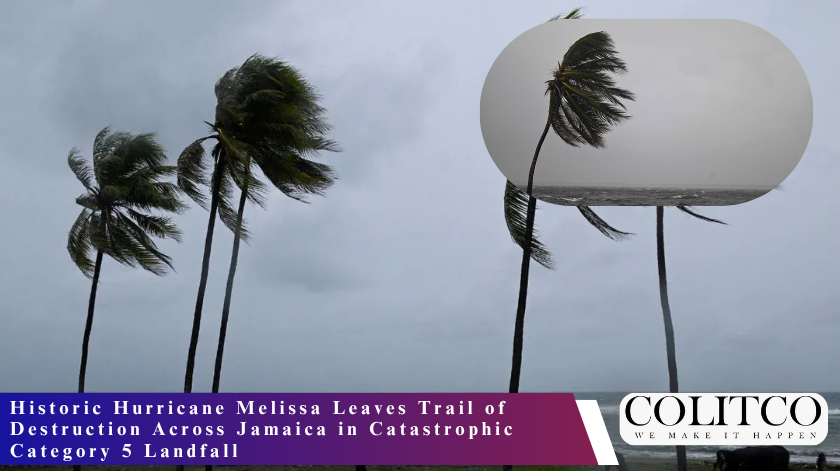Hurricane Melissa tore through Jamaica on Tuesday, delivering one of the most devastating blows in Caribbean history as it made landfall with maximum sustained winds of 185mph.
The monster Category 5 storm struck near New Hope in western Jamaica at 1pm local time, marking the first Atlantic hurricane to hit land at Category 5 strength since Hurricane Dorian in 2019.
Prime Minister Andrew Holness declared the nation a disaster area as the full scale of destruction began emerging across the island of 2.8 million people.
Unprecedented Fury Overwhelms Island Nation
Jamaica faced its strongest hurricane since record-keeping began in 1851, surpassing the devastation of Hurricane Gilbert that struck in 1988 as a Category 3 storm.
Melissa’s 185mph winds and 892 millibar central pressure tied records for the strongest Atlantic storm at landfall.
Hurricane Melissa slammed into southwest Jamaica overnight, killing seven and leaving over half a million without power. Officials say 25,000 tourists are stranded as the storm heads toward Cuba, where 700,000 have been evacuated. pic.twitter.com/tj7t3E88t8
— Open Source Intel (@Osint613) October 29, 2025
The catastrophic system spent 36 consecutive hours at Category 5 intensity, placing it among only five hurricanes since 1969 to maintain such strength for an extended period.
Heavy floodwaters swept across southwestern Jamaica, winds tore roofs off buildings and boulders tumbled onto roads as the hurricane unleashed nature’s most intense fury.
Key damage reports include:
- Four main hospitals damaged, with one losing power forcing evacuation of 75 patients
- Complete roof torn off Savanna La Mar Public General Hospital
- Black River Police Station severely flooded, destroying court documents and case files
- 540,000 customers or 77% without power
- Widespread landslides, fallen trees and infrastructure collapse
Deadly Toll and Humanitarian Crisis Unfolds
The storm claimed at least seven lives across the Caribbean, including three deaths in Jamaica during storm preparations.
Two people died after trees fell on them while cutting them down, and one was electrocuted, according to Health Minister Christopher Tufton.
An additional 13 people suffered injuries, mostly from falls during preparation efforts.
Prime Minister Holness said the storm “ravaged” the country, with western parishes bearing the brunt of destruction.
Deputy Chairman of Jamaica’s Disaster Risk Management Council Desmond McKenzie cautioned that cleanup and damage assessment would be slow.
“There is no infrastructure in the region that can withstand a Category 5,” Holness stated. “The question now is the speed of recovery.”
Storm’s Unique Danger: Slow Movement Amplifies Devastation
Melissa’s crawling pace heightened the danger significantly.
AccuWeather’s exclusive analysis revealed the hurricane’s average forward speed of just 4.6mph was the slowest on record for any hurricane in that Caribbean region since 1971.
This sluggish movement meant communities endured extreme conditions for hours rather than the typical rapid passage.
Jamaica faced 20 to 30 inches of rain with isolated totals exceeding 40 inches in the eastern mountains, triggering catastrophic flash flooding and numerous landslides.
The storm also drove a life-threatening storm surge of up to 13 feet along Jamaica’s southern coast, cutting off entire communities.
Scenes from Jamaica during Hurricane Melissa pic.twitter.com/bM7xbmjFgn
— Nature is Amazing ☘️ (@AMAZlNGNATURE) October 29, 2025
Widespread Infrastructure Collapse
Nearly 15,000 people sought refuge in shelters as Melissa passed over the island.
Most families sheltered in place despite government evacuation orders for flood-prone communities.
Colin Bogle, a Mercy Corps adviser sheltering in Portmore, described the experience: “The noise is relentless. Everything went dark after a loud explosion.”
In Kingston, authorities issued unusual warnings for residents to watch for crocodiles displaced from their habitats by flooding.
Tourist areas including Montego Bay suffered “very, very heavy” impacts, with approximately 25,000 tourists stranded on the island.
Tourism Minister Edmund Bartlett said Kingston’s airport could reopen for special rescue and humanitarian flights as early as Wednesday.
International Response Mobilizes
The British government positioned specialist rapid deployment teams to assist thousands of UK nationals in Jamaica.
Foreign Secretary Yvette Cooper confirmed readiness to deliver humanitarian aid if requested by Jamaican authorities.
China’s Red Cross pre-positioned hundreds of family kits containing essential supplies in eastern Cuba ahead of the hurricane’s expected landfall there.
The UN’s International Organization for Migration dispatched solar lamps, blankets, generators and other critical items from its Barbados logistics hub.
Storm Continues Deadly Path
After crossing Jamaica, Melissa regained strength and made landfall in Cuba as a Category 3 hurricane around 3am Wednesday.
Cuban authorities evacuated more than 700,000 people ahead of the storm’s arrival in Santiago de Cuba and surrounding provinces.
The hurricane was forecast to strike the southeastern Bahamas Wednesday evening before potentially impacting Bermuda and Atlantic Canada.
Also Read: Australia’s Inflation Surprise: What the 1.3% CPI Jump Means for Your Mortgage
Climate Context and Future Implications
Melissa represents the third Category 5 hurricane of the 2025 Atlantic season, following Hurricanes Erin in August and Humberto in September.
Only the 2005 season produced more Category 5 storms, with four reaching that intensity.
Experts warn that recovery from such a powerful storm could take months or even years.
Storm chaser Brandon Clement, reporting from Jamaica, predicted a humanitarian crisis: “It’s going to take months for things to even begin to resemble normalcy after this.”
As dawn broke Wednesday over Jamaica, the full extent of Melissa’s destruction remained unclear, with many communities isolated by floodwaters and debris.
The resilient island nation now faces the monumental task of rebuilding from one of the most powerful hurricanes ever recorded in the Atlantic basin.












